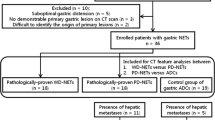Abstract
Objective
The differentiation of poorly-differentiated neuroendocrine tumours (PD-NETs), well-differentiated NETs (WD-NETs), and adenocarcinomas (ADCs) is important due to different management options and prognoses. This study is to find the differential CT features of colorectal PD-NETs from WD-NETs and ADCs.
Materials and methods
CT features of 25 colorectal WD-NETs, 36 PD-NETs, and 36 ADCs were retrospectively reviewed. Significant variables were assessed using univariate and multivariate analyses. Receiver operating characteristics analysis determined the optimal cut-off value of tumour and lymph node (LN) size.
Results
Large size, rectum location, ulceroinfiltrative morphology without intact overlying mucosa, heterogeneous attenuation with necrosis, presence of ≥3 enlarged LNs, and metastasis were significant variables to differentiate PD-NETs from WD-NETs (P < 0.05). High attenuation on arterial phase, persistently high enhancement pattern, presence of ≥6 enlarged LNs, large LN size, and wash-in/wash-out enhancement pattern of liver metastasis were significant variables to differentiate PD-NETs from ADCs (P < 0.05).
Conclusions
Compared to WD-NETs, colorectal PD-NETs are usually large, heterogeneous, and ulceroinfiltrative mass without intact overlying mucosa involving enlarged LNs and metastasis. High attenuation on arterial phase, presence of enlarged LNs with larger size and greater number, and wash-in/wash-out enhancement pattern of liver metastasis can be useful CT discriminators of PD-NETs from ADCs.
Key Points
• Compared to WD-NETs, PD-NETs more frequently accompany enlarged LNs and metastases.
• Metastatic LNs from PD-NETs are significantly larger than those from ADCs.
• Hepatic metastases from PD-NETs usually show early enhancement and delayed washout.



Similar content being viewed by others
Abbreviations
- WD-NET:
-
Well-differentiated neuroendocrine tumour
- PD-NET:
-
Poorly-differentiated neuroendocrine tumour
- ADC:
-
Adenocarcinoma
- CT:
-
Computed tomography
- LN:
-
Lymph node
- ROC:
-
Receiver operating characteristics
- AUC:
-
Area under the curve
References
Yao JC, Hassan M, Phan A et al (2008) One hundred years after "carcinoid": epidemiology of and prognostic factors for neuroendocrine tumors in 35,825 cases in the United States. J Clin Oncol 26:3063–3072
Bosman FT, Carneiro F, Hruban RH, Theise ND (eds) (2010) WHO classification of tumours of the digestive system. IARC France, Lyon
Rindi G, Kloppel G, Alhman H et al (2006) TNM staging of foregut (neuro)endocrine tumors: a consensus proposal including a grading system. Virchows Arch 449:395–401
Strosberg JR, Coppola D, Klimstra DS et al (2010) The NANETS consensus guidelines for the diagnosis and management of poorly differentiated (high-grade) extrapulmonary neuroendocrine carcinomas. Pancreas 39:799–800
Hainsworth JD, Spigel DR, Litchy S, Greco FA (2006) Phase II trial of paclitaxel, carboplatin, and etoposide in advanced poorly differentiated neuroendocrine carcinoma: a Minnie Pearl Cancer Research Network Study. J Clin Oncol 24:3548–3554
Shafqat H, Ali S, Salhab M, Olszewski AJ (2015) Survival of patients with neuroendocrine carcinoma of the colon and rectum: a population-based analysis. Dis Colon Rectum 58:294–303
Kim SH, Kim SH, Kim MA, Shin CI, Han JK, Choi BI (2015) CT differentiation of poorly-differentiated gastric neuroendocrine tumours from well-differentiated neuroendocrine tumours and gastric adenocarcinomas. Eur Radiol 25:1946–1957
Kim TH, Kim SH, Lee KB, Han JK (2016) Outcome and CT differentiation of gallbladder neuroendocrine tumours from adenocarcinomas. Eur Radiol. doi:10.1007/s00330-016-4394-3
Ganeshan D, Bhosale P, Yang T, Kundra V (2013) Imaging features of carcinoid tumors of the gastrointestinal tract. Am J Roentgenol 201:773–786
Reznek RH (2006) CT/MRI of neuroendocrine tumours. Cancer Imaging 6:S163–S177
Chi YK, Zhang XP, Li J, Sun YS (2011) To be or not to be: significance of lymph nodes on pretreatment CT in predicting survival of rectal cancer patients. Eur J Radiol 77:473–477
Kim JH, Beets GL, Kim MJ, Kessels AG, Beets-Tan RG (2004) High-resolution MR imaging for nodal staging in rectal cancer: are there any criteria in addition to the size? Eur J Radiol 52:78–83
Díez M, Teulé A, Salazar R (2013) Gastroenteropancreatic neuroendocrine tumors: diagnosis and treatment. Ann Gastroenterol 26:29–36
Sahani DV, Bonaffini PA, Fernández-Del Castillo C, Blake MA (2013) Gastroenteropancreatic neuroendocrine tumors: role of imaging in diagnosis and management. Radiology 266:38–61
Konishi T, Watanabe T, Nagawa H et al (2010) Treatment of colorectal carcinoids: a new paradigm. World J Gastrointest Surg 2:153–156
Seow-Choen F, Ho J, Jetmore AB (1993) Tiny carcinoids may be malignant. Dis Colon Rectum 36:309–310
Dromain C, de Baere T, Baudin E et al (2003) MR imaging of hepatic metastases caused by neuroendocrine tumors: comparing four techniques. Am J Roentgenol 180:121–128
Ni S-J, Sheng W-Q, Du X (2010) Pathologic research update of colorectal neuroendocrine tumors. World J Gastroenterol 16:1713–1719
Acknowledgements
The scientific guarantor of this publication is Se Hyung Kim, Associate Professor, Department of Radiology, Seoul National University Hospital. The authors of this manuscript declare no relationships with any companies, whose products or services may be related to the subject matter of the article. This research was supported by Seoul National University Hospital Research Fund No. 04-2015-620 and was supported by the Basic Science Research Program through the National Research Foundation of Korea [NRF] funded by the Ministry of Science, ICT & Future Planning [NRF-2016R1A2B4007762]. No complex statistical methods were necessary for this paper. Institutional Review Board approval was obtained. Written informed consent was waived by the Institutional Review Board.
Methodology: retrospective, observational, performed at one institution.
Author information
Authors and Affiliations
Corresponding author
Rights and permissions
About this article
Cite this article
Kang, J.H., Kim, S.H. & Han, J.K. Poorly-differentiated colorectal neuroendocrine tumour: CT differentiation from well-differentiated neuroendocrine tumour and poorly-differentiated adenocarcinomas. Eur Radiol 27, 3867–3876 (2017). https://doi.org/10.1007/s00330-017-4764-5
Received:
Revised:
Accepted:
Published:
Issue Date:
DOI: https://doi.org/10.1007/s00330-017-4764-5




